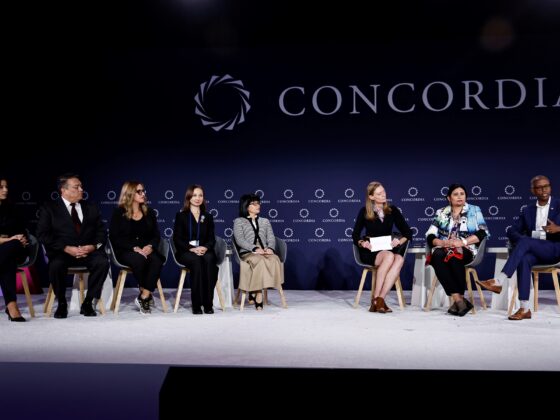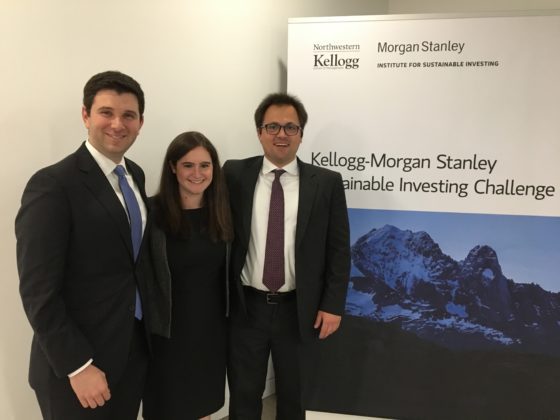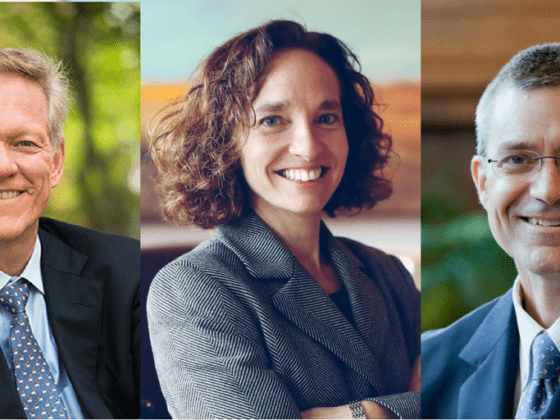By Mel Phillips MBA 2026
Darden’s Sustainability Conference 2024 showcased the extraordinary progress and challenges in the global energy transition, delivering a compelling vision of the opportunities within clean energy technologies, strategic investments, and innovative policies. Through dynamic panels and in-depth discussions, the event highlighted the critical components shaping this revolution—from greening the grid and leveraging AI to tackling industrial decarbonization and addressing public policy hurdles.
Renewable Energy Panel
Manoj Sinha (Darden ‘09) — Founder, Husk Power
Mary Sotos — Director of the Federal Energy Management Program at the U.S. Department of Energy (DOE)
Pablo Barrague (Darden ‘15) — VP of Energy Storage, MEI Investments
Tess Engebretson (Darden ‘20) — Project Leader, Boston Consulting Group
Central to the energy transition is “greening the grid,” which involves not only powering it with renewable energy but also enabling broader decarbonization of transportation, heating, and industry. The scale of this challenge is immense; for example, a recent report finds that decarbonizing steel mills in the US will require 174 terawatt-hours of carbon-free electricity annually by 2050.
AI is emerging as both a driver of energy demand and a tool for optimization. Its predictive capabilities enhance grid management, improve energy efficiency, and support innovations like virtual power plants. Together, AI and batteries are key to meeting the complex demands of a decarbonized grid.
Batteries are pivotal in stabilizing renewable energy supply, ensuring reliability, and reducing reliance on fossil fuels. Despite uncertainties surrounding potential policy changes following the 2024 election, energy storage should remain a bipartisan priority. Batteries lower electricity costs, create jobs, and enhance energy security, cementing their role as a cornerstone of U.S. energy policy. While adjustments to tax incentives or increased tariffs on foreign imports could challenge the sector, domestic investments in battery supply chains are poised to mitigate these risks and drive future growth.
The Climate Investment Panel
Tanuj Deora — Advisor, Hygge Power
Alex Katzman (Darden ‘10) — VP of Business Development, ChargeScape
Paul Straub — Founder, Wireframe Ventures
Amanda Gex (Darden ‘21) — Investor, FM Capital
Panelists highlighted the challenges posed by high interest rates in this capital-intensive industry, emphasizing that while projects with strong IRRs exist, the difficulty in validating input assumptions often results in high-risk premiums and the need for government support.
Early-stage startups typically find funding more accessible, but Series B and C rounds face significant hurdles due to investors demanding demonstrated traction. The panel also discussed the distinct financing needs of capital-intensive sectors like SAFs and industrial decarbonization, which require innovative underwriting solutions like off-take agreements to combine technology and project risk.
Public market trends were noted to cascade into private funding, influencing the viability of emerging business models. While M&A activity and IPOs were identified as critical for unlocking liquidity and sustaining investor confidence, concerns about overvaluation and the misalignment of market expectations were prominent. Emerging sectors, including distributed energy resources, virtual power plants, and second-life batteries, hold significant promise but face financing barriers due to unclear pathways and reliance on government incentives.
Macroeconomic shifts, such as the rising electricity demand from AI and electrification, were highlighted as transformative forces reshaping investment strategies and opportunities. Ultimately, the panel stressed the importance of aligning funding mechanisms with market growth, fostering innovation, and ensuring the scalability of clean energy solutions.
An Entrepreneurial Experience with Biomass
Thomas Meth (Darden ’02) — Head of Biomass, Javelin Global Commodities shared a deep dive into the challenges and opportunities in scaling renewable hydrocarbons for industrial decarbonization. Meth emphasized the critical role biomass plays in replacing fossil fuels in hard-to-electrify sectors like steel and lime production. Drawing on 20 years of experience, Meth detailed the complexities of biomass, particularly its sourcing, scalability, and perception challenges. He explained how agricultural biomass often faces public scrutiny over food competition, while woody biomass, though more sustainable, is also contentious due to its association with deforestation concerns.
Meth highlighted the evolution of his company’s business model, from its origins in mobilizing underutilized byproducts of the U.S. pulp and paper industry to exporting high-demand renewable carbon products to European and Asian markets. The shift to long-term off-take agreements with industrial clients, such as power plants and lime kilns, enabled the company to secure financing and scale its operations, despite biomass’s inherent challenges—such as high water content, heterogeneity, and transport risks.
One of the key takeaways was the role of regulation and market incentives in driving growth. Meth explained how Europe’s Renewable Energy Directive created a favorable regulatory framework, enabling coal-to-biomass conversions and emphasizing emissions reductions. The U.S. government’s support for forest product markets also proved crucial in maintaining private landownership and preventing deforestation. However, the rise of inflation and unforeseen cost escalations strained the company’s ability to meet its growth targets, underscoring the unpredictable nature of capital-intensive projects in the energy transition.
Meth shared candid insights into the pressures of scaling, going public, and managing stakeholders. Transitioning to a publicly traded company increased regulatory compliance costs and brought heightened scrutiny from investors, regulators, and environmental groups. Engagement with NGOs like The Nature Conservancy proved pivotal in addressing sustainability concerns, resulting in innovative solutions like conservation trusts to protect forested areas while supporting landowners.
Meth’s reflections on entrepreneurship emphasized the importance of managing assumptions and maintaining transparency with investors. He cautioned against over-reliance on favorable cost structures and highlighted the need to adapt business strategies in response to changing market conditions. His closing advice to aspiring entrepreneurs underscored the inevitability of challenges in energy innovation but also the transformative opportunities to decarbonize hard-to-abate sectors, calling for resilience, clarity, and a bold approach to tackling the energy transition.
Corporate Sustainability as a Strategic Imperative
Betty Cremmins — Director, Office of the Federal Chief Sustainability Officer at The White House
Blake O’ Brien (Darden ‘10) — Director of Sustainability, Dominion Energy
Arianna Molino — Sustainability Manager, Kearney
Maggie Tucker (Darden ‘24) — Global Sustainability Leader, Barry-Wehmiller
This panel explored how businesses integrate sustainability into their operations while engaging stakeholders, driving accountability through disclosures, and aligning ESG initiatives with financial goals. Panelists highlighted the importance of tailoring strategies to different stakeholders, including investors, customers, employees, and regulators. For example, Dominion Energy’s Blake detailed how the company communicates both detailed ESG metrics and long-term sustainability narratives to build trust and drive alignment across diverse groups.
Regional differences in sustainability pressures emerged as a key theme. Ariana from Kearney explained that Europe’s strict regulations, like the CSRD, push companies toward compliance, while the Middle East relies more on voluntary measures driven by government visions and international investors. Betty added that the U.S. takes an incentive-based approach, emphasizing tax credits under the Inflation Reduction Act, compared to Europe’s mandate-heavy framework. Maggie noted that businesses operating globally must adapt to these varied regulatory environments while also responding to growing employee and customer demand for sustainability.
The panel also explored how sustainability can drive financial value. Ariana cited examples like energy efficiency measures reducing operating costs and green product innovations creating new revenue streams. Blake discussed Dominion’s use of sustainability-linked credit facilities, which tie financial savings to meeting ESG goals. Betty highlighted how supply chain collaborations, such as sector-specific consortiums, allow companies to share resources and reduce risks while achieving sustainability objectives.
Ultimately, the panel emphasized the need for businesses to balance short-term financial accountability with long-term sustainability goals. By leveraging transparency, storytelling, and tailored strategies, companies can align sustainability efforts with stakeholder expectations while navigating a rapidly evolving global landscape.
Federal Policy Panel
Jay Vaingankar — Advisor, DOE Policy
Hieu Le (Darden ‘24) — Senior Advisor, EPA
John McAuliff — Senior Climate Advisor, Rural Business-Cooperative Service at USDA
This panel focused on the intersection of government, private sector collaboration, and innovation in advancing the clean energy transition. Panelists highlighted the significant impact of landmark legislation like the Inflation Reduction Act (IRA) and the Bipartisan Infrastructure Law, which together allocated unprecedented funds to clean energy initiatives. Hugh from the EPA discussed the agency’s dual role in enforcing regulatory standards and managing $100 billion in new funding from the IRA, noting that projects like the Greenhouse Gas Reduction Fund are already driving transformative change, such as financing Arkansas’s largest solar development.
Collaboration with the private sector emerged as a critical theme. Jay emphasized that policies like tax credits for clean energy production are designed to catalyze private sector investment, with $415 billion in clean energy investments already made and over 330,000 jobs created. Panelists stressed that private sector feedback during implementation, especially on technical feasibility and supply chain needs, is essential for the success of these programs. For example, offshore wind developers worked with federal agencies to shape domestic content requirements, ensuring both feasibility and progress toward building a U.S. manufacturing base for specialized steel.
The panel also explored bipartisan opportunities within clean energy policy. John noted that rural economic development, national security, and supply chain independence resonate across political lines, as evidenced by broad support for the clean energy manufacturing investments spurred by the IRA. He highlighted how clean energy projects, often located in historically industrial regions, are creating jobs and revitalizing communities, fostering political and public support. The panelists agreed that local permitting and land-use issues are the next critical challenges to address as federal policy shifts from legislation to implementation.
Innovation was another focal point, with emerging technologies like perovskite solar cells and industrial decarbonization methods discussed as key enablers of deeper emission reductions. Hugh pointed out that decarbonizing sectors like cement and heavy-duty transportation will require breakthroughs beyond current renewable energy solutions. The panel concluded by encouraging future leaders to engage with federal agencies, not only to influence policy but also to contribute technical expertise and drive innovation, ensuring the clean energy transition remains nonpartisan and sustainable in the long term.
A Call to Action
Darden’s Sustainability Conference 2024 reinforced the urgency and potential of the clean energy transition. From scaling geothermal energy to tackling industrial emissions and optimizing DERs, the challenges are vast but surmountable with bold leadership and informed collaboration. As this transformative era unfolds, it will be up to today’s innovators, policymakers, and business leaders to seize the boundless opportunities ahead.
The future is being shaped now—what role will you play?





